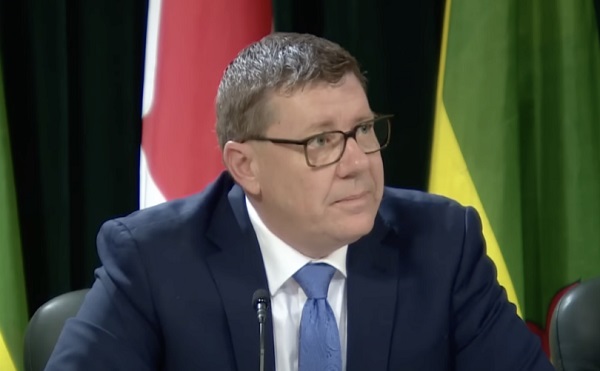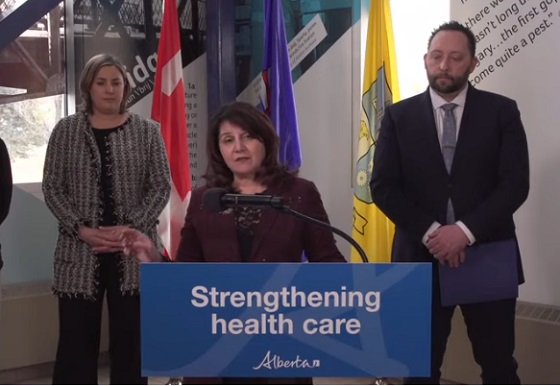Business
UN’s COP29 conference pledges $300 billion a year for ‘climate change’ in third world nations to help them transition to alternative energy

COP29 International Climate Change Event Concept. Baku, Azerbaijan
From LifeSiteNews
The deal may already be moot with Donald Trump returning to the White House
The international COP29 conference finished over the weekend with multinational pledges to spend billions of dollars over the next decade combating “climate change” in third world nations, amid expectations that the agreement will be rendered moot by former President Donald Trump’s return to the White House.
Just the News reports that the conference, among the almost 200 nations who signed onto the United Nations Framework Convention on Climate Change in 1992, ended with a mutual commitment to spend $300 billion every year until 2035 helping poor countries mitigate the so-called effects of “climate change” and transition to alternative energy.
India representative Chandni Raina wanted the conference to commit to $1.3 trillion a year, and lamented $300 billion as “abysmally poor” and a “paltry sum” that would not suffice to “address the enormity of the challenge we all face.”
Another group in attendance, the America-based Committee For A Constructive Tomorrow (CFACT), had a very different conclusion, as CFACT dissents from the green agenda of the international establishment.
“Nations such as China and India are given a pass on emissions reductions and paying out funds,” noted CFACT’s Craig Rucker. “This, despite the fact that China is the world’s number one emitter of greenhouse gases and boasts the second largest economy, while India’s economy is all the way up at number five.”
Regardless, the conference’s deliberations may already be moot, as Trump is widely expected to withdraw the United States from the Paris Climate Agreement upon resuming office in January, which in turn would eliminate America’s share of the funding for COP29.
Trump formally pulled out of the Paris accords in August 2017, the first year of his first term, with then-U.S. Ambassador to the United Nations Nikki Haley stating that the administration would be “open to re-engaging in the Paris Agreement if the United States can identify terms that are more favorable to it, its business, its workers, its people, and its taxpayers.”
Such terms were never reached, however, leaving America out until Trump’s successor, outgoing President Joe Biden, re-committed the nation to the Paris Agreement on the first day of his presidency, obligating U.S. policy to new economic regulations to cut carbon emissions.
In June, the Trump campaign confirmed Trump’s intentions to withdraw from Paris again. At the time, Trump’s team was reportedly mulling a number of non-finalized drafts of executive orders to do so.
Left-wing consternation on the matter is based on certitude in “anthropogenic global warming” (AGW) or “climate change,” the thesis that human activity, rather than natural phenomena, is primarily responsible for Earth’s changing climate and that such trends pose a danger to the planet in the form of rising sea levels and weather instability.
Activists have long claimed there is a “97 percent scientific consensus” in favor of AGW, but that number comes from a distortion of an overview of 11,944 papers from peer-reviewed journals, 66.4 percent of which expressed no opinion on the question; in fact, many of the authors identified with the AGW “consensus” later spoke out to say their positions had been misrepresented.
AGW proponents suffered a blow in 2010 with the discovery that their leading researchers at the Intergovernmental Panel on Climate Change, East Anglia Climate Research Unit, and National Oceanic and Atmospheric Administration had engaged in widespread data manipulation, flawed climate models, misrepresentation of sources, and suppression of dissenting findings in order to make the so-called “settled science” say what climate activists wanted it to.
Business
Saskatchewan becomes first Canadian province to fully eliminate carbon tax

From LifeSiteNews
Saskatchewan has become the first Canadian province to free itself entirely of the carbon tax.
On March 27, Saskatchewan Premier Scott Moe announced the removal of the provincial industrial carbon tax beginning April 1, boosting the province’s industry and making Saskatchewan the first carbon tax free province.
Under Moe’s direction, Saskatchewan has dropped the industrial carbon tax which he says will allow Saskatchewan to thrive under a “tariff environment.”
“I would hope that all of the parties running in the federal election would agree with those objectives and allow the provinces to regulate in this area without imposing the federal backstop,” he continued.
The removal of the tax is estimated to save Saskatchewan residents up to 18 cents a liter in gas prices.
The removal of the tax will take place on April 1, the same day the consumer carbon tax will reduce to 0 percent under Prime Minister Mark Carney’s direction. Notably, Carney did not scrap the carbon tax legislation: he just reduced its current rate to zero. This means it could come back at any time.
Furthermore, while Carney has dropped the consumer carbon tax, he has previously revealed that he wishes to implement a corporation carbon tax, the effects of which many argued would trickle down to all Canadians.
The Saskatchewan Association of Rural Municipalities (SARM) celebrated Moe’s move, noting that the carbon tax was especially difficult on farmers.
“I think the carbon tax has been in place for approximately six years now coming up in April and the cost keeps going up every year,” SARM president Bill Huber said.
“It puts our farming community and our business people in rural municipalities at a competitive disadvantage, having to pay this and compete on the world stage,” he continued.
“We’ve got a carbon tax on power — and that’s going to be gone now — and propane and natural gas and we use them more and more every year, with grain drying and different things in our farming operations,” he explained.
“I know most producers that have grain drying systems have three-phase power. If they haven’t got natural gas, they have propane to fire those dryers. And that cost goes on and on at a high level, and it’s made us more noncompetitive on a world stage,” Huber decalred.
The carbon tax is wildly unpopular and blamed for the rising cost of living throughout Canada. Currently, Canadians living in provinces under the federal carbon pricing scheme pay $80 per tonne.
Automotive
Electric cars just another poor climate policy

From the Fraser Institute
The electric car is widely seen as a symbol of a simple, clean solution to climate change. In reality, it’s inefficient, reliant on massive subsidies, and leaves behind a trail of pollution and death that is seldom acknowledged.
We are constantly reminded by climate activists and politicians that electric cars are cleaner, cheaper, and better. Canada and many other countries have promised to prohibit the sale of new gas and diesel cars within a decade. But if electric cars are really so good, why would we need to ban the alternatives?
And why has Canada needed to subsidize each electric car with a minimum $5,000 from the federal government and more from provincial governments to get them bought? Many people are not sold on the idea of an electric car because they worry about having to plan out where and when to recharge. They don’t want to wait for an uncomfortable amount of time while recharging; they don’t want to pay significantly more for the electric car and then see its used-car value decline much faster. For people not privileged to own their own house, recharging is a real challenge. Surveys show that only 15 per cent of Canadians and 11 per cent of Americans want to buy an electric car.
The main environmental selling point of an electric car is that it doesn’t pollute. It is true that its engine doesn’t produce any CO₂ while driving, but it still emits carbon in other ways. Manufacturing the car generates emissions—especially producing the battery which requires a large amount of energy, mostly achieved with coal in China. So even when an electric car is being recharged with clean power in BC, over its lifetime it will emit about one-third of an equivalent gasoline car. When recharged in Alberta, it will emit almost three-quarters.
In some parts of the world, like India, so much of the power comes from coal that electric cars end up emitting more CO₂ than gasoline cars. Across the world, on average, the International Energy Agency estimates that an electric car using the global average mix of power sources over its lifetime will emit nearly half as much CO₂ as a gasoline-driven car, saving about 22 tonnes of CO₂.
But using an electric car to cut emissions is incredibly ineffective. On America’s longest-established carbon trading system, you could buy 22 tonnes of carbon emission cuts for about $660 (US$460). Yet, Ottawa is subsidizing every electric car to the tune of $5,000 or nearly ten times as much, which increases even more if provincial subsidies are included. And since about half of those electrical vehicles would have been bought anyway, it is likely that Canada has spent nearly twenty-times too much cutting CO₂ with electric cars than it could have. To put it differently, Canada could have cut twenty-times more CO₂ for the same amount of money.
Moreover, all these estimates assume that electric cars are driven as far as gasoline cars. They are not. In the US, nine-in-ten households with an electric car actually have one, two or more non-electric cars, with most including an SUV, truck or minivan. Moreover, the electric car is usually driven less than half as much as the other vehicles, which means the CO₂ emission reduction is much smaller. Subsidized electric cars are typically a ‘second’ car for rich people to show off their environmental credentials.
Electric cars are also 320–440 kilograms heavier than equivalent gasoline cars because of their enormous batteries. This means they will wear down roads faster, and cost societies more. They will also cause more air pollution by shredding more particulates from tire and road wear along with their brakes. Now, gasoline cars also pollute through combustion, but electric cars in total pollute more, both from tire and road wear and from forcing more power stations online, often the most polluting ones. The latest meta-study shows that overall electric cars are worse on particulate air pollution. Another study found that in two-thirds of US states, electric cars cause more of the most dangerous particulate air pollution than gasoline-powered cars.
These heavy electric cars are also more dangerous when involved in accidents, because heavy cars more often kill the other party. A study in Nature shows that in total, heavier electric cars will cause so many more deaths that the toll could outweigh the total climate benefits from reduced CO₂ emissions.
Many pundits suggest electric car sales will dominate gasoline cars within a few decades, but the reality is starkly different. A 2023-estimate from the Biden Administration shows that even in 2050, more than two-thirds of all cars globally will still be powered by gas or diesel.
Source: US Energy Information Administration, reference scenario, October 2023
Fossil fuel cars, vast majority is gasoline, also some diesel, all light duty vehicles, the remaining % is mostly LPG.
Electric vehicles will only take over when innovation has made them better and cheaper for real. For now, electric cars run not mostly on electricity but on bad policy and subsidies, costing hundreds of billions of dollars, blocking consumers from choosing the cars they want, and achieving virtually nothing for climate change.
-

 2025 Federal Election1 day ago
2025 Federal Election1 day agoPoilievre To Create ‘Canada First’ National Energy Corridor
-

 2025 Federal Election1 day ago
2025 Federal Election1 day agoJoe Tay Says He Contacted RCMP for Protection, Demands Carney Fire MP Over “Bounty” Remark
-

 2025 Federal Election2 days ago
2025 Federal Election2 days agoChinese Election Interference – NDP reaction to bounty on Conservative candidate
-

 2025 Federal Election2 days ago
2025 Federal Election2 days agoHong Kong-Canadian Groups Demand PM Carney Drop Liberal Candidate Over “Bounty” Remark Supporting CCP Repression
-

 2025 Federal Election1 day ago
2025 Federal Election1 day agoLondon-Based Human Rights Group Urges RCMP to Investigate Liberal MP for Possible Counselling of Kidnapping
-

 Daily Caller20 hours ago
Daily Caller20 hours agoBiden Administration Was Secretly More Involved In Ukraine Than It Let On, Investigation Reveals
-

 2025 Federal Election1 day ago
2025 Federal Election1 day agoAlcohol tax and MP pay hike tomorrow (April 1)
-

 Business19 hours ago
Business19 hours agoTrump says ‘nicer,’ ‘kinder’ tariffs will generate federal revenue










